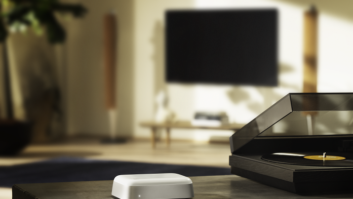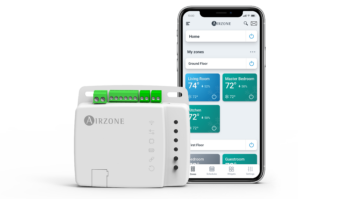LAS VEGAS —
JVC is celebrating its 30th anniversary
in the U.S. car audio aftermarket by increasing car audio
connectivity to a device that didn’t exist in 1982: the cellphone.
Here at International CES, JVC is:
• adopting advanced external mode to enable head-unit
control of most of the functions of select apps running on
a USB-connected iPod Touch or iPhone;
• adopting Bluetooth’s serial port protocol (SPP) for the
first time to expand the number of Pandora Internet radio
functions that a head unit can control on a Bluetooth-connected
Android smartphone;
• adding iPod Out mode to its A/V multimedia units, enabling
the heads’ large screens to display a user interface
transferred from a connected iPod/iPhone; and
• enhancing head units’ USB ports to provide basic
navigation from the head units of music stored on a USBconnected
Android or BlackBerry smartphone.
In other developments, JVC is:
• expanding its selection of head units with embedded
HD Radio to nine from six at prices starting at an everyday
$119;
• adding HD Radio’s channel guide and bookmark functions
for the first time in two A/V-navigation units;
• launching its first three digital media receivers (DMRs),
which lack CD mechanism; and
• launching its first head units with connection to the
new SiriusXM universal tuner. The connection is turning
up in all but one A/V-multimedia head unit and in all A/Vnavigation
units.
Here are the details of these and other developments:
Advanced external mode
: New multimedia A/V
head units are the company’s first with advanced external
mode, which enables the head units to control key functions
of multiple compatible apps on a USB-connected
iPhone. The apps include MOG on-demand music, Tune
In Internet radio, MotionX-GPS Drive, SonicMax for JVC
and Inrix traffic.
In JVC’s 2011 lineup, most head units priced down to an
everyday $109 had iPod-enabled USB ports whose App
Mode, or external mode, enabled the streaming of audio
content from iPhone-stored apps and, in multimedia-A/V
units, the display of maps from the Motion X navigation
app. External mode, however, didn’t let users control the
apps from their head units.
Advanced external mode appears in four new double-
DIN A/V multimedia units priced at an expected everyday
$429 to $579. A fifth new A/V multimedia unit lacks the
feature.
Bluetooth SPP mode
: The company is adopting
Bluetooth’s SPP in select heads to control more functions
on Pandora apps running on Android and Black-
Berry smartphones than can be controlled via Bluetooth’s
AVRCP (audio video remote control profile).
SPP is appearing for the first time in six
single-DIN CD receivers, three double-DIN
receivers, and in two of the company’s first
three DMRs.
With SPP and a free JVC App for Android,
users can also use their Android phone’s
touchscreen to control almost every feature
of the connected head units.
With AVRCP, head-unit control of smartphone
Internet radio apps is limited to track/
station up/down and play/pause, but with
SPP, control is extended to such Pandora
functions as thumbs up/down, station-list
menu for channel selection, and bookmarklist
menu.
This year, the company is extending AVRCP
down to $139 in one of the company’s
first DMRs.
iPod Out
: For the first time, JVC is adding
iPod Out mode to its A/V multimedia units, enabling the heads’ larger screens
to display a user interface transferred from
a connected iPod/iPhone. The feature has
also begun to appear in OEM head units.
With iPod Out, head-unit controls operate
faster than they do with a head unit supplier’s
proprietary iPod interface because
the iPod-transferred interfaces don’t need
to process interface data sent by an iPod.
The iPod Out menu appearing on the JVC
head’s screen look like iPod Classic interfaces.
With iPod Out, head units can also display
album art in a larger format than album
art appearing on other iPod-controlling A/V
head units.
USB mass storage
: In its CD receivers
and DMRs, the company improved its USB
ports to control song selection on Android
and BlackBerry smartphones. When the
phones are in mass-storage mode, consumers
can use the head units’ controls to
navigate songs by selecting folders and by
selecting individual songs via the track up/
down button. The USB ports also charge
the smartphones.
The USB mass-storage feature is available
in all head units equipped with USB,
with so-equipped CD receivers starting at
an everyday $119 and DMRs starting at
$109.
Pandora, iHeartRadio control via
iPhone USB
: The company is expanding
control of a Pandora app on a USB-connected
iPhone to A/V multimedia units for
the first time, adding it to four of five new
A/V models and to all new A/V-nav units.
The feature was available in 2011 only in
four single-DIN CD receivers.
iHeartRadio control was available in two
A/V-navigation units in the 2011 line and
has been expanded to all four new A/V-nav
units in 2012.
DMRs:
The company is launching its first
DMRs, or single-DIN head units without CD
mechanism,positioning them as low-cost alternatives
to CD receivers.
HD Radio:
The company is expanding its
selection of heads with embedded HD Radio
to nine units from six, including two navigation
systems, at prices starting at $119,
down from the 2011 line’s opening price of
$129. Eight of these models feature iTunes
tagging.
The company is also adopting two new HD
Radio features in its two HD-Radio-equipped
nav systems, the $999 KWNT500HD with
6.1-inch touchscreen and $1,299 KWNT800HD
with 7-inch touchscreen.
One feature is a channel guide that captures
metadata broadcast by HD Radio
stations and RDS FM stations broadcast
to display the titles of programs and songs
currently playing across multiple stations.
The second feature is a bookmark function
that improves upon iTunes tagging.













